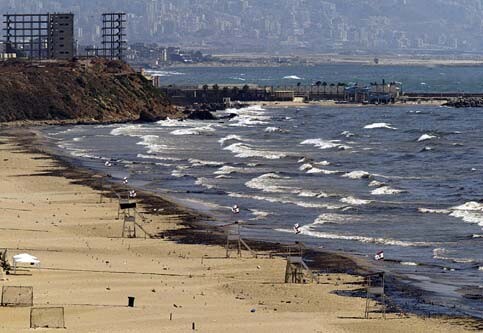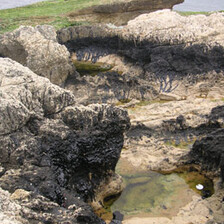IPS 22 November 2006

Ramlet el-Baida public beach is badly polluted after more than 10,000 tonnes of heavy fuel oil escaped into the Mediterranean when Israeli air strikes hit tanks at a power plant in the coastal village of El-Jiye, 30km south of Beirut, 3 July 2006. (Haitham Mossawi/IRIN)
Squally winter weather in the eastern Mediterranean poses a fresh threat to marine ecology from Lebanon to Turkey this year, due to the remnants of the oil slick caused in July when Israeli forces bombed a power plant south of Beirut.
Between 10,000 and 15,000 tonnes of crude leaked from the crippled power plant of Jiyeh, 30 km from the Lebanese capital, Jul. 13-15. The spill seriously contaminated the waters along the Lebanese and Syrian coast. Environmental damage to neighbouring Cyprus, Greece and Turkey was somewhat reduced by operations to mop up the floating oil.
But the danger persists. Highly specialised teams with extensive experience need to immediately get down to work cleaning rocks and buildings before winter storms lash the region, warns the Malta-based Regional Marine Emergency Response Centre for the Mediterranean Sea (REMPEC).
Endangered marine species are feeling the effects of the oil spill, and now that the migratory season has begun, scientists fear for the fate of thousands of birds at sites like Lebanon’s Palm Islands Nature Reserve.
The spill from the Jiyeh plant was the result of Israel’s 33-day bombing campaign against Lebanon after militias from the pro-Syrian Shiite group Hezbollah kidnapped two Israeli soldiers. After the Aug. 14 ceasefire, Lebanese officials calculated that the conflict had claimed the lives of at least 1,100 civilians.
It wasn’t until Oct. 13 that manual recovery of sunken oil with specialised equipment began, from around the power plant. A team of Italian divers has estimated that up to 600 cubic metres of oil could be found on the seabed. Assisting them is an unidentified non-governmental organisation.
There are also divers from the United Arab Emirates (UAE) waiting to help with the clean-up. With experience gained most recently from relief work in Thailand and Sri Lanka following the Dec. 26, 2004 tsunami, the team from the Emirates Diving Association is awaiting the green light from the Lebanese authorities.
“We are ready to go and help assess the extent of damage below the surface. I know that expert teams are already at the sites,” Ibrahim Al-Zubi, director of the association’s environmental department, said in an interview.
Following the day and night bombings in July by Israeli jets, a mission set up by the Lebanese Ministry of Environment and experts from the World Conservation Union (IUCN) found the beaches, caves and rocks covered with oil. The shoreline, famous as a playground for West Asia’s rich, is home to the rare loggerhead turtle (Caretta caretta) and monk seal (Monachus monachus).
“People who live off the sea will remember this pollution all their lives. It will stain their memory forever,” said Xavier Kremer, a French oil-spill expert with CEDRE, an NGO which specialises in investigating water pollution.
Describing the spill as Lebanon’s worst-ever environmental disaster, Environment Minister Yacoub Sarraf told the press “clean-up costs could reach 100 million dollars.”
“Even species living at the bottom of the sea have not escaped contamination, and innovative techniques must be developed to remove oil,” said Rick Steiner, an oil expert and member of the IUCN commission on environmental and economic social policy.
Preliminary shoreline examinations have found toxic substances such as polynuclear aromatic hydrocarbons (PAH). “PAHs provoke cancer, can accumulate in the species’ organs and cause long-term impacts such as the sudden collapse of fish populations years after contamination, as was the case in Alaska,” he explained, referring to his experience from the 1989 Exxon-Valdez spill involving 37,000 tonnes of oil.
On Aug. 17, the International Maritime Organisation (IMO) and the United Nations Environment Programme (UNEP) met in Athens and agreed on a 65-million-dollar action plan to assist Lebanese authorities with the clean-up. Other countries like Algeria, Cyprus, Greece, France, Italy, Malta, Spain, and Syria, also pledged support.
The Lebanon Council for Development and Reconstruction puts the direct costs of the Israel-Hezbollah conflict damage to infrastructure at 3.6 billion dollars, though some analysts say the figure could triple.
Several sandy beaches that are known nesting sites for two sea turtle species, loggerhead and green (Chelonia mydas) turtles, have been affected, especially in Beirut and the Palm Islands Nature Reserve, outside the northwestern Lebanese city of Tripoli. The oil covering the reserve’s rocky coasts has already killed algae and other organisms that fish and turtles feed on.
Mona Khalil, who has been monitoring turtles in Lebanon for some six years, said in an interview that “most probably the newly hatched baby turtles that enter the water near Palm Islands will die as they will encounter oil when they come up for air.”
“Hatchlings may also be exposed to residual oil on beaches as well as in offshore waters. Such exposure could result in acute mortality and/or sub-lethal effects including carcinogenesis, physiological and reproductive impairment,” said Steiner.
Ornithologist and Palm Islands manager Ghassan Jaradi, who has seen oil-doused birds, is concerned about more such cases emerging as the season for coastal bird migration has just begun. Around 156 species of birds, including many migratory birds, may already have had direct contact with the contaminated water.
The rare monk seals, which have been spotted in the reserve’s waters, could also be affected. They are listed on the IUCN Red List of Threatened Species.
“Palm Islands, which is one of Lebanon’s most important staging areas for migrant birds and is protected under the RAMSAR Convention on Wetlands, is a micro-sample representing the overall situation of the country’s marine environment,” said Ghassan.
The 1971 Ramsar Convention, named for the Iranian city where it was signed, calls for preserving essential wetland ecosystems as sources of water and biodiversity.
The IUCN mission has already helped start clean-up operations and biodiversity monitoring. But CEDRE’s Kremer has warned: “After cleaning most of the oil, there will still be around one percent left on the waters. People will have the impression the beaches are still polluted.”
This story is part of a series of features on sustainable development by IPS (Inter Press Service) and IFEJ (International Federation of Environmental Journalists).
Related Links

